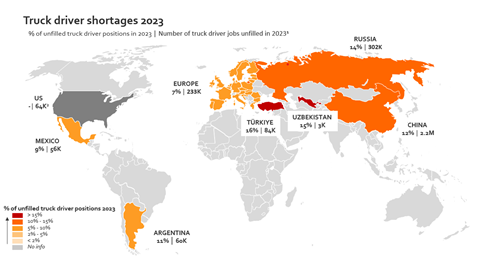Surveying over 4,700 trucking companies in the Americas, Asia and Europe, the IRU has found that truck driver shortages increased globally in 2023 and over 3 million driver positions are currently unfilled in 36 countries studied.

Two exceptions were Europe and the USA where shortages eased slightly in 2023. This was due to softer transport demand as a result of inflation and tighter monetary policy limiting consumption and investment.
Still, the shortage is forecast to get much worse in the coming years, said the IRU. Without action to attract and retain drivers, over 7 million truck driver positions could be unfilled by 2028 in the surveyed countries, including 4.9 million in China (20 percent of total positions), 745,000 in Europe (17 percent of total positions), and 200,000 in Türkiye (28 percent of total positions).
IRU secretary general Umberto de Pretto said: “The structural issues behind truck driver shortages are continuing to impact transport services. With the rate of newcomers being significantly lower than drivers retiring every year, urgent action is needed now. We are missing over 3 million truck drivers in the countries we’ve examined. Given the demographics of the profession, we forecast that it could double within five years.”
He added that operators are doing their part, but governments and authorities need to increase efforts to improve working conditions and access to the profession. At least 50 percent of road transport operators have serious problems hiring skilled drivers, in most countries studied. Many are also unable to expand their business and are losing existing clients and revenues.
The truck driver profession has an ageing population: less than 12 percent of truck drivers are below 25 years old, falling to 5 percent in Europe. The share of female truck drivers also continues to remain low at only 6 percent, below the overall transport industry. China (6 percent) and the USA (8 percent) have the highest share of women truck drivers, among the countries studied.
The “school-to-wheel” gap is a key challenge facing the industry. The minimum driving age for international freight transport is still between 21 and 26 in some countries. High training, licence and insurance costs also make it expensive to become a truck driver. In France, for example, the average cost to obtain a truck driver licence and a Certificate of Professional Competence is EUR5,250 (USD5,750) over three times the minimum monthly wage. The IRU believes that governments need to facilitate access to the profession by lowering the minimum driving age and subsidising qualification costs.
















